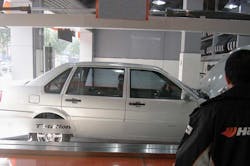Success has many fathers, as the saying goes. One sire to my company’s exponential growth (the Tires Plus stores) was our obsession with improving the way we did things. We were fanatical about identifying roadblocks, unearthing errors, and fine-tuning our system. Part of our campaign included benchmarking the highfliers; and one way we did that was an occasional intel-gathering field trip.
Once, we chartered a twin-prop plane for our regional managers, my right-hand man Wayne Shimer and me to investigate a top national tire chain’s Omaha locations. The company had a great reputation and did a lot of things right — and they were about to invade the Twin Cities, our most lucrative market.
We split into three teams, rented cars, and went shopping. We got oil changes at every store and watched their MO.
“While we waited,” Wayne recalled, “I’d say to the manager, ‘That looks like a great computer system. How does it work?’ And he’d explain the whole thing in detail.”
We flew home fat with improvements that we immediately clicked into place, like installing windows between the bays and the lobby so customers could watch the progress on their cars.
“Looking back,” Wayne said, “the cost and the time to load us all onto a charter and fly us back and forth to Omaha, I mean, that’s crazy. Or is it? It takes a lot of passion and drive to be the best.”
The big boys tend to pursue structural precision through a process called Lean Enterprise, a hybrid of TQM (Total Quality Management) and JIT (Just In Time).
Essentially, Lean Enterprise integrates quality commitment, waste elimination and employee involvement within a structured management system. Its primary purpose is to perform all functions — from product development and production to sales and customer service — so that steps that don’t create value for the end user are eliminated. This allows steps that do create value to flow unimpeded in the value stream.
Clearly, Lean Enterprise demands a thorough understanding of customer needs, as does Six Sigma, a rigorous, empirical method of eliminating defects in all systems. Six Sigma, conceived by the late Bill Smith, a reliability engineer at Motorola, defines a defect as anything outside of customer specifications. General Electric claims that Six Sigma produced $10 billion in benefits in just five years.
[PAGEBREAK]There aren’t many companies saving $2 billion annually. And small businesses often don’t have budgets for TQM, JIT or Lean Enterprise. But you can save plenty on systems issues by troubleshooting the disease rather than the symptom. Business owners operating with a “seat-of-the-pants” attitude do the exact opposite — they focus on the errors (symptoms) caused by the system (disease). Don’t have a formal strategy for improvement? Get in the game by taking these steps.
• Seek employee input. They’re in the thick of the action, so every month ask each person, “What’s working and what isn’t?”
• Implore employees to report all errors as soon as they happen. Welcome mistakes with open arms. Finding and fixing errors prevents major headaches down the road.
• Abandon any part of the system as soon as a better way emerges.
• Set up a hotline number. Some employees aren’t comfortable making even the smallest wave. Partner with a loss-prevention company to provide a hotline for employees to confidentially offer suggestions and point out problems.
• Establish system-improvement committees to hunt bottlenecks in your systems, from machines and materials to communication and training. Do whatever it takes to repair broken links.
• Partner with a consultant specializing in Lean Enterprise, Six Sigma or some other highly regarded system-improvement specialist, if the expected benefits exceed the cost in time and money.
Key points
To build a systems-disciplined organization:
• Focus on strategic planning. It’s the cornerstone of a proactive, healthy organization. Don’t let the process intimidate you. Strategic planning exploits your strengths and opportunities and diminishes your weaknesses and threats.
• Execute in four steps. Define expectations, then inspire, teach and follow up. The execution solution helps employees avoid obstacles, or get back on track when they do trip up.
• Methodically solve problems. When an individual or department underperforms, don’t blame, shame, panic or pander. Cooperate and explore, don’t fight and accuse. The right attitude and the right systems turn problem solving into no problem at all.
[PAGEBREAK]• Manage your meetings. Disorganized meetings waste time and drain energy. Productive meetings run on tight pre-meeting preparation and strict protocol.
• Troubleshooting is a year-round sport. Beyond high- concept theories like Total Quality Management, tell your people that their company is a work in progress. Dedicate yourself to continuous process improvement. Constantly scout the competition, abandon bad systems, establish internal hotlines and consider partnering with consultants. ■
This article is one of a series from “The Big Book of Small Business” by Tom Gegax with Phil Bolsta. Copyright 2005, 2006 by Tom Gegax. Published by arrangement with HarperCollins Publishers.
Best-selling author Tom Gegax, co-founder and chairman emeritus of Tires Plus stores, served as that company’s chairman and CEO for 24 years. By the time he sold the company in July 2000, it had mushroomed from a concept sketched on a restaurant napkin to a market leader with 150 upscale stores in 10 states and $200 million in revenue.
Thanks to Tom’s warm-hearted, tough-minded approach to management, and his team’s relentless focus on customer service, the company’s turnover rate ranked among the industry’s lowest, and its guest enthusiasm index reached 98%. He was named Modern Tire Dealer’s Tire Dealer of the Year in 1998 and a Midwest Entrepreneur of the Year by Inc. magazine.
In 2000, Gegax founded Gegax Management Systems (www.gegax.com) to help growing companies raise profits and reduce stress through fast and affordable business management guidance.




